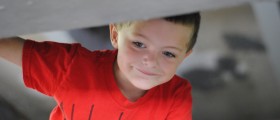
Autism is a disorder of neural development that usually shows first signs before the child is 3 years old. Typical facial features, repetitive behavior, limited interests, and impaired social interaction and communication characterize this disorder. Children with autism are often faced with unique developmental challenges. If a disorder is diagnosed early and a treatment begins when the child is still young, it may help to gain certain self-care, social, and communication skills. Depending on the severity of their symptoms, children with autism have difficulty forming relationships, communicating with others, and limited and repetitive interests and behavior. Working with autistic children. Therefore, often requires a lot of interaction with the child’s family and their close ones. The biggest challenge, however, is reaching the child and understanding the way they are looking at the world around them.
Working with Children with Autism
Child affected with autism may seem to be the same as any other child, but the typical symptoms and behaviors associated with this disorder may be quite disruptive and often require a lot understanding. Children with autism need to be integrated into the educational system, but not as fast as other kids. Each of their activities, including learning and therapy, has to be performed in a well-defined environment and up to the strict schedule.
Tips for Working with Children with Autism
Parents, teachers, and anybody working with autistic children, are often very much confused and may often feel overwhelmed. However, useful advices can help to adapt to the children and improve communication with them.
When working with autistic children, people should think and teach visually, since many of these kids are exclusively visual thinkers and learners. For this reason, educators should use visual technology: television, computers, projectors, and anything that is able to transmit visual information.
Sometimes this may be very hard to accomplish since the children tend to limit their interest to one narrow area. Educators should try to use that special interest or fixation to connect with the child and increase their attention.
Children with autism are also very prone to environmental distractions. Bright lights or loud sounds may interfere with their learning. Therefore, it is very much important to plan their environment carefully and adopt it to the child’s particular needs.
Another challenge is that children with autism commonly associate acquired skills with one specific location. For example, if you teach the child to use a spoon instead of fingers, a child may not realize this is something that is equally important to do at home and at any other place.

















Your thoughts on this
Loading...